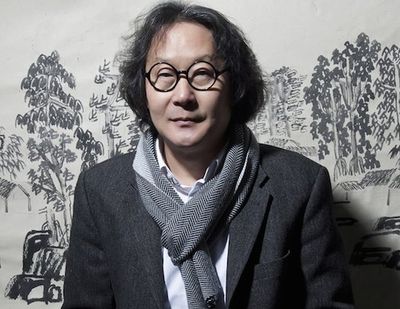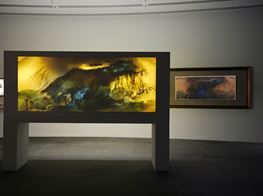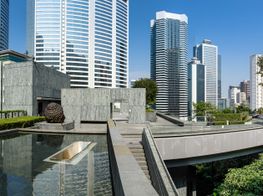Xu Bing

Xu Bing is a Chinese-born artist, who was resident in the United States for over ten years, but now lives in Beijing, where he serves as the president of the Central Academy of Fine Arts. He is most well known for his printmaking and installation pieces, as well as the use of text to investigate how language and its presentation impacts our understanding of the world.
An early installation like Book from the Sky, involved the artist inventing 4,000 characters and hand-carving them into wood blocks, then using them as moveable type to print volumes and scrolls, which are displayed laid out on the floor and hung from the ceiling. The vast planes of text seem to convey ancient wisdom, but are in fact unintelligible.
Since then, Xu Bing has gone on to use unexpected materials including tobacco leaves, debris, and silkworms, to meditate on the transformative power of materiality while continuing to query societal values, and the formation of knowledge systems, memories, culture and history.
Asia Society is currently hosting the artist's first-ever solo exhibition in Hong Kong. The exhibition, entitled It Begins with Metamorphosis: Xu Bing, is curated by Yeewan Koon, and features a cross-section of Xu Bing's well-known works, as well as some of his latest works.
In this interview with Xu Bing and curator Yeewan Koon, the artist discusses Andy Warhol, the universality of symbols, and how context changes art; and Yeewan Koon explains what she hopes audiences viewing the exhibition will take away from it.
My interest in expressing contemporary life has remained the same. What has changed, and this is relevant to why my work has changed, is community, society, and culture.
ADYou have mentioned before that Andy Warhol was someone who, at the very beginning of your career, influenced you. What was it about his work that resonated with you?
XBI first encountered Andy Warhol through images in a magazine showing three silk screen-prints, each depicting the same portrait image of Mrs Jackie Kennedy. What intrigued me was the use of repetition in printmaking. I was interested in why Andy Warhol would create three identical prints.
ADAnd how did that translate into your work from there?
XBI don't think I would say he directly influenced my work, but I was struck by the repetition, and I then wrote a paper on the study of repetition. Seeing his work influenced me to explore the subject of repetition, and to intellectualise it.
I was interested in Andy Warhol's investigation into the relationship between fine art and contemporary culture. One of the key characteristics of contemporary culture is the use of duplicates. We use the same icons and symbols across cultures—every plug symbol looks the same, for example—and it made me aware of the universality of such things. So from his work, I saw an extension from the concept of repetition to this concept of universality.
ADIf we draw a bridge between the early days, and the art you produce today—what do you think has been the biggest change in the way you make and think about the art you produce?
XBAs an artist, I still feel I am the same. My interest in expressing contemporary life has remained the same. What has changed, and this is relevant to why my work has changed, is community, society, and culture. My art is always speaking to contemporary life, so my art has changed as contemporary life has changed. An artist is always adapting what he wants to express as the world around him changes.
ADMany of the works in this exhibition are new editions of earlier works. However, expanding on your previous answer, do you view these works nevertheless in many ways unique because of the different context in which they were made, and are presented?
XBYes, I do. The changes in our culture have changed the work. When a work is made it relates to a specific emotion at a specific point-in-time, so from my perspective it changes each time it is made. From an audience perspective, it also changes—because the audience's context has also changed over time.
ADSo the work is different for every person who views a work?
XBYes.
One of the key characteristics of contemporary culture is the use of duplicates. We use the same icons and symbols across cultures—every plug symbol looks the same, for example—and it made me aware of the universality of such things.
[Yeewan Koon joins the conversation]
ADYeewan, when you look at this exhibition, what do you want the audience to take away from Xu Bing's practice that they didn't maybe know before?
YKGood question. One of the things that everybody knows Xu Bing for is his interest in words and language, and also his interest in systems of knowledge; that is reflected in this exhibition and it is a crucial part of who he is. But I also think there are a lot of other things that people don't know about him (or pay attention to as much)—well the story certainly hasn't been told in Hong Kong—and it is a story about process and about making. Very much of what he does is about having a very intimate engagement with material and that was something I wanted to make sure people took away.
I also think he has changed as an artist in some ways, not in terms of who he is as a person, but the way his art has expressed different things. There is more humanity—a greater sense of human presence in some ways—so using things such as rubbish or things that people have handled. And I think that is a more intimate engagement that people are not so aware of.
ADDid you think about the Hong Kong audience in curating this exhibition?
YKWe certainly thought about our audience. We wanted to have a variety of artworks that would engage people at different levels. Many people will know classical Chinese paintings, for example—so his work exploring that aspect will be interesting to them—we wanted to make the exhibition accessible to as many people as possible.
The changes in our culture have changed the work. When a work is made it relates to a specific emotion at a specific point-in-time, so from my perspective it changes each time it is made. From an audience perspective, it also changes—because the audience's context has also changed over time.
ADIn the exhibition, Xu Bing's studio or office is reproduced. I viewed it as a reminder about how much of his work has also been autobiographical. For example, Xu Bing uses tobacco in his work and this references his father's lung cancer.
YKWell, yes. Each of the rooms in the exhibition is designed to convey something about Xu Bing personally. So the first one with the silk worms is relevant to Xu Bing's own description of his approach to work — he has described himself as being like a silkworm in the way he simply and diligently goes about working each day.
The next room includes the office, and is intended to act as a reminder of the actual process he undertakes to make the work.
The third room is relevant to print—showing a more recent work—but acts as a reminder of his artistic roots, which were in print.
ADWhat next for Xu Bing?
XBA lot of people think I am very creative, and the new works come easily. But I worry all the time about what I will create next. I just try to stay focused on the times and the changes in society, and I aim to form a new understanding of the world—and if I do this, then the ability to create a new art language is easier. —[O]













































































































































































